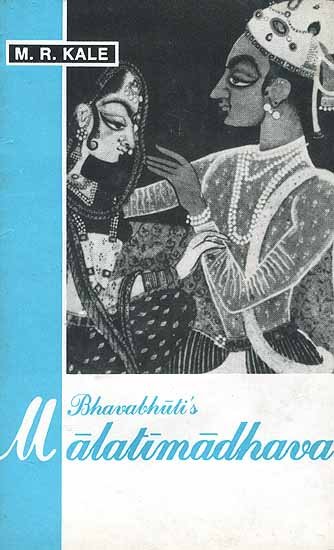Malatimadhava (study)
by Jintu Moni Dutta | 2017 | 52,468 words | ISBN-10: 8120813057 | ISBN-13: 9788120813052
This page relates ‘Ojas Guna (Floridity)’ from the English study on the Malatimadhava of Bhavabhuti:—A Prakarana type of Drama in ten acts revolving around the love-story of Malati (from Padmāvatī) and Madhava (from Vidarbha). This study discusses the history of its author and the literary, social, religious, historical and cultural aspects of the Malatimadhava.
Part 4.3b - Ojas Guṇa (Floridity)
Ojaḥ [Ojas] is the force affected by the presence or profusion of compounds which is regarded as the soul of prose.[1] According to Bharata, a piece of composition containing many compounds of different types and striking word is said to have the merit of ojaḥ.[2] Viśvanāha opines that this quality is the source of the lustrous expansion and glow of the heart and this quality exists in a excessive degree in case of sentiments like Vīra, Bībhatsa,and Raudra [3] Mammaṭabhaṭṭa, who has given his view in regard to Ojas guṇa.[4] The combination of the first and of the third consonants of a group with the consonants following them, of any consonant with r and of any two similar consonants, the consonants beginning with ṭa, the consonants śa, ṣa, long compounds and the ornamental diction are the suggestive of floridity.[5]
In the Mālatīmādhava, Bhavabhūti has used Ojas guṇa in delineation of sentiments such as Vīra, Bībhatsa and Raudra.
(i)Ojas Guṇa in Vīra rasa:
Bhavabhūti has deliberately used Ojas guṇa in Vīra rasa in the Mālatīmādhava. As for instance in the verse asāraṃ saṃsāram.........etc[6] wherein words such as parimuṣita, śaraṇam exist with the letters ṣa and śa. Again in the word jagajjīrṇāraṇyaṃ the conjunct form of third letter ja is found. Hence, this verse is a suitable example of Ojas guṇa. Likewise, there are some other verses (V. 27,31,32) wherein the use of the letters such as ṣa, śa, ṭa, ḍa and consonants with ra and words with long compound are found.
(ii) Ojas Guṇa in Bībhatsa Rasa:
Bhavabhūti has appropriately made the use of Ojas guṇa in Bībhatsa rasa. As for instance in the verse niṣtāpasvidyasthanaḥ kvatha....... etc[7] the use of the letters ṣa, śa, ṭa, are found. Moreover, long compounded words such as niṣṭāpasvidyadasthanaḥ, utpakvastraṃsimāṃsaṃ are found and in the word majjadhāraḥ the adjunct form of two similar consonants ja is found.Hence, this verse is a suitable example of Ojas guṇa.
(iii) Ojas Guṇa in Raudra rasa:
The poet has deliberately used Ojas guṇa in Raudra rasa. As for instance, in the verse paryantapratirodhimeduracayastyānaṃ..........etc[8] the conjunct form of two similar consonants are found in the word duttālāḥ, consonant ṣa is found in the word citājyotiṣā, ṭa is found in the words such as prakaṭayatyā, kaṭapūtanā and it also consists of long compounded words such as paryantapratirodhimeduracayastyānaṃ, saṃsaktākulakelayaḥ, kaṭaputanāprabhṛtayaḥ. Hence, the verse is a beautiful example of Ojas guṇa.
Footnotes and references:
[1]:
ojaḥ samāsabhūyastvametad gadyasya jīvitam /
Kāvyālaṃkāra,II.2
[2]:
avagīto’pi hino’pi syādudāttāvabhāsakaḥ /
yatra śabdārtha sampattistadojaḥ parikīrtitam //
Nāṭyaśāstra,XVI.106
[3]:
Sāhityadarpaṇa,VIII.4
[4]:
dīptyātmavistṛterheturaujo vīrarasasthiti /
vībhatsaraudrarasayostasyādhikyaṃ krameṇa ca //
Kāvyaprakāśa,VIII.69
[5]:
[6]:
[7]:
niṣtāpasvidyasthanaḥ kvathanaparinamanmedasaḥ pretakāyām /
kṛṣṭvā samsaktadhūmānamapi kuṇapabhujo bhūyasībhyaścitābhyaḥ //
utpakvastramasimāṃsaṃ pracaladubhayataḥ samdhinirmuktamārād /
ete niṣkuṣya jaṅghānalakamudayinīrmajjadhārāh pivanti //
Ibid.,V.17
[8]:
paryantapratirodhimeduracayastyānaṃ citā jyotiṣā /
mojjvalyaṃ parabhāgataḥ prakaṭayatyābhogabhīmam //
saṃsaktākulakaleyaḥ kilakilākolāhalaiḥ saṃmadā /
duttālāḥ kaṭapūtanāprabhṛtayaḥ sāṃrāviṇaṃ kurvate //
Ibid.,V.11
